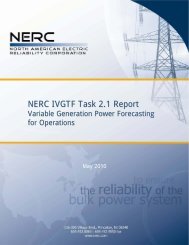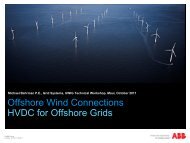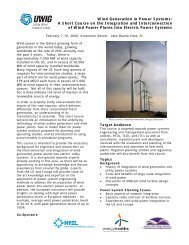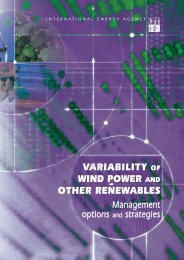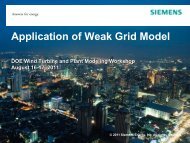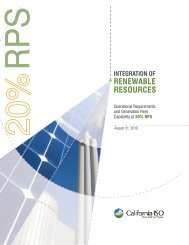Integrating Southwest Power Pool Wind to Southeast Electricity ...
Integrating Southwest Power Pool Wind to Southeast Electricity ...
Integrating Southwest Power Pool Wind to Southeast Electricity ...
Create successful ePaper yourself
Turn your PDF publications into a flip-book with our unique Google optimized e-Paper software.
<strong>Wind</strong> Delivery (MW)<br />
12000<br />
10000<br />
8000<br />
6000<br />
4000<br />
2000<br />
0<br />
0:00 1:00 2:00 3:00<br />
Time in hours<br />
4:00 5:00 6:00<br />
Figure 3-7<br />
Worst short term event<br />
In addition <strong>to</strong> the wind production data, the dataset for this study also contained a day-ahead<br />
forecast of the wind production that exhibited the approximate error characteristics of current<br />
state of the art forecast models. Individual wind plant forecasts have an MAE (mean absolute<br />
error) of 17% on average for all of the sites used in the study. However, the aggregation effects<br />
discussed earlier apply <strong>to</strong> the forecasts as well. The statistics for the forecast for each of the<br />
regions is shown in Table 3-3. These DA forecasts of wind output are used in the day-ahead<br />
commitment process of the SCUC/SCED simulations ensuring that the actual DA forecast errors<br />
have <strong>to</strong> be accommodated during the real-time dispatch using resources online or expensive<br />
quick start generation.<br />
Table 3-3<br />
<strong>Wind</strong> production forecast error statistics<br />
Worst Short Term Event<br />
ENTERGY SOCO SPP TVA Footprint<br />
MAE %Nameplate 8.3% 7.6% 8.6% 8.0% 7.7%<br />
MAE MW 653 1141 1268 829 3710<br />
Max Error 37% 35% 44% 35% 37%<br />
Reserve Requirements<br />
The increased variability and uncertainty from wind power causes an increase in operating<br />
reserve requirements. Those requirements have <strong>to</strong> be provided by some combination of flexible<br />
generation and responsive load. Together, these contribute <strong>to</strong> the operating reserve that is<br />
available <strong>to</strong> help manage the wind and load variability. This reserve is calculated dynamically,<br />
and is a function of the observed variability of the wind power and the load. A methodology was<br />
developed <strong>to</strong> estimate the increased requirements for reserves with wind variability in the<br />
Eastern <strong>Wind</strong> Integration and Transmission Study (EWITS).<br />
Short-term variability is challenging because it is difficult <strong>to</strong> fully anticipate the scheduling<br />
changes and fluctuations that must be covered with reserves. In a system with 10-minute or<br />
faster dispatch update cycles, a typical approach is <strong>to</strong> forecast a flat value for wind output for the<br />
3-8<br />
SPP Entergy<br />
SoCo TVA




